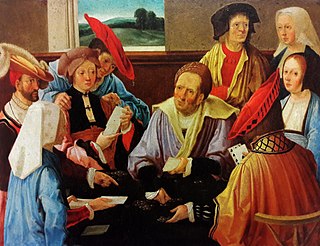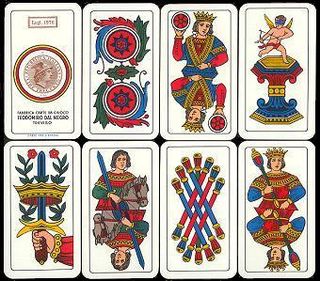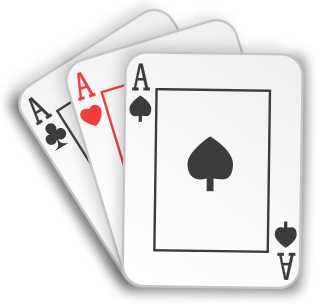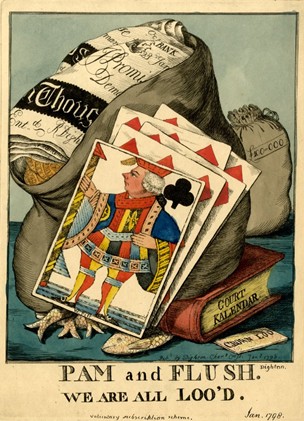
Blackjack is a casino banking game. It is the most widely played casino banking game in the world. It uses decks of 52 cards and descends from a global family of casino banking games known as "twenty-one". This family of card games also includes the European games vingt-et-un and pontoon, and the Russian game Ochko. The game is a comparing card game where players compete against the dealer, rather than each other.

A card game is any game that uses playing cards as the primary device with which the game is played, whether the cards are of a traditional design or specifically created for the game (proprietary). Countless card games exist, including families of related games. A small number of card games played with traditional decks have formally standardized rules with international tournaments being held, but most are folk games whose rules may vary by region, culture, location or from circle to circle.

Poker is a family of comparing card games in which players wager over which hand is best according to that specific game's rules. It is played worldwide, but in some places the rules may vary. While the earliest known form of the game was played with just 20 cards, today it is usually played with a standard 52-card deck, although in countries where short packs are common, it may be played with 32, 40 or 48 cards. Thus poker games vary in deck configuration, the number of cards in play, the number dealt face up or face down and the number shared by all players, but all have rules that involve one or more rounds of betting.
Pai gow poker is a version of pai gow that is played with playing cards, instead of traditional pai gow's Chinese dominoes. The game of pai gow poker was created in 1985 in the United States by Sam Torosian, owner of the Bell Card Club.

Video poker is a casino game based on five-card draw poker. It is played on a computerized console similar in size to a slot machine.

Brag is an 18th century British card game, and the British national representative of the vying or "bluffing" family of gambling games. It is a descendant of the Elizabethan game of Primero and one of the several ancestors to poker, the modern version just varying in betting style and hand rankings. It has been described as the "longest-standing British representative of the Poker family."

Primo visto, Primavista, Prima-vista, Primi-vist, Primiuiste, Primofistula, or even Primefisto, is a 16th-century gambling card game fashionable c. 1530–1640. Very little is known about this game, but judging by the etymology of the words used to describe the many local variants of the game, it appears to be one of Italian origin.

Thirty-one or Trente et un is a gambling card game played by two to seven people, where players attempt to assemble a hand which totals 31. Such a goal has formed the whole or part of various games like Commerce, Cribbage, Trentuno, and Wit and Reason since the 15th century. 31 is popular in America and Britain.

Card counting is a blackjack strategy used to determine whether the player or the dealer has an advantage on the next hand. Card counters try to overcome the casino house edge by keeping a running count of high and low valued cards dealt. They generally bet more when they have an advantage and less when the dealer has an advantage. They also change playing decisions based on the composition of the deck and sometimes play in teams.

Scopa is an Italian card game, and one of the three major national card games in Italy, the others being Briscola and Tresette. It is also popular in Argentina and Brazil, brought in by Italian immigrants, mostly in the Scopa a Quindici variation. Scopa is also played in former Italian colonies such as Libya and Somalia or some other countries like Tunisia and even Morocco, with changed appearance in the cards. It is played with a standard Italian 40-card deck, mostly between two players or four in two partnerships, but it can also be played by three or six players.
Razz is a form of stud poker that is normally played for ace-to-five low. It is one of the oldest forms of poker, and has been played since the start of the 20th century. It emerged around the time people started using the 52-card deck instead of 20 for poker.

Four Card Poker is a casino card game similar to Three Card Poker, invented by Roger Snow and owned by Shuffle Master.

Teen patti is a gambling card game. Teen Patti originated in India and is popular throughout South Asia. It originated in the English game of three-card brag, with influences from poker. It is also called flush or flash in some areas.

Malaysian Pontoon is a card game related to Pontoon and blackjack and, like those games, a descendant of Vingt-Un or Twenty-One. It is played by those in Australia, Malaysia and Singapore, where it is usually just called pontoon. This game is similar to match play 21 or Spanish 21, while original pontoon, played in Britain, holds closer to the traditional Twenty-One rules, but can be quickly distinguished by the use of the terms "twist" and "stick".
Guts is a comparing card game, or family of card games, related to poker. Guts is a gambling game involving a series of deals of 2, 3, or 4 cards. Hand are ranked similarly to hands in poker. The betting during each deal is simple : all players decide whether they are "in" or "out", and announce this at the same time. Each deal has its own showdown, after which the losers match or increase the pot, which grows rapidly. A round of the game ends when only one person stays in and wins the pot.
Stud poker is any of a number of poker variants in which each player receives a mix of face-down and face-up cards dealt in multiple betting rounds. Stud games are also typically non-positional games, meaning that the player who bets first on each round may change from round to round. The cards dealt face down to each individual player are called hole cards, which gave rise to the common English expression ace in the hole for any hidden advantage.

Lanterloo or loo is a 17th-century trick taking game of the trump family of which many varieties are recorded. It belongs to a line of card games whose members include Nap, euchre, rams, hombre, and maw. It is considered a modification of the game of "all fours", another English game possibly of Dutch origin, in which the players replenish their hands after each round by drawing each fresh new cards from the pack.

Gilet, also Gile, Gillet, is a 16th-century Italian gambling card game that probably predates the game of Primero. Rabelais, in 1534, gives it pride of place in his list of games played by Gargantua, and Cardano, in 1564, describes it as Geleus, from the word Geleo, meaning "I have it".

Belle, Flux et Trente-et-Un, is an historical, gambling card game that was widespread in France and Germany during the 17th and 18th centuries. As a relative of Brag and Poch, from which the game of Poker developed, it is of cultural-historical interest.

















